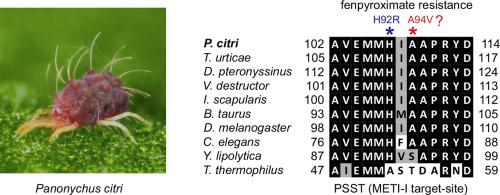当前位置:
X-MOL 学术
›
Pestic. Biochem. Phys.
›
论文详情
Our official English website, www.x-mol.net, welcomes your feedback! (Note: you will need to create a separate account there.)
Molecular and genetic analysis of resistance to METI-I acaricides in Iranian populations of the citrus red mite Panonychus citri
Pesticide Biochemistry and Physiology ( IF 4.7 ) Pub Date : 2020-03-01 , DOI: 10.1016/j.pestbp.2019.12.009 Elaheh Shafiei Alavijeh , Jahangir Khajehali , Simon Snoeck , Rafaela Panteleri , Mohammad Ghadamyari , Wim Jonckheere , Sabina Bajda , Corinna Saalwaechter , Sven Geibel , Vassilis Douris , John Vontas , Thomas Van Leeuwen , Wannes Dermauw
Pesticide Biochemistry and Physiology ( IF 4.7 ) Pub Date : 2020-03-01 , DOI: 10.1016/j.pestbp.2019.12.009 Elaheh Shafiei Alavijeh , Jahangir Khajehali , Simon Snoeck , Rafaela Panteleri , Mohammad Ghadamyari , Wim Jonckheere , Sabina Bajda , Corinna Saalwaechter , Sven Geibel , Vassilis Douris , John Vontas , Thomas Van Leeuwen , Wannes Dermauw

|
The citrus red mite, Panonychus citri, is a major pest on citrus all around the world. Mitochondrial Electron Transport Inhibitors of complex I (METI-I) acaricides such as fenpyroximate have been used extensively to control P. citri populations, which resulted in multiple reports of METI-I resistant populations in the field. In this study, biochemical and molecular mechanisms of fenpyroximate resistance were investigated in P. citri. Seven populations were collected from Northern provinces of Iran. Resistance ratios were determined and reached up to 75-fold in comparison to a fenpyroximate susceptible population. Cross-resistance to two additional METI-I acaricides, pyridaben and tebufenpyrad, was detected. PBO synergism experiments, in vivo enzyme assays and gene expression analysis suggest a minor involvement of cytochrome P450 monooxygenases in fenpyroximate resistance, which is in contrast with many reported cases for the closely related Tetranychus urticae. Next, we determined the frequency of a well-known mutation in the target-site of METI-Is, the PSST subunit, associated with METI-I resistance. Indeed, the H92R substitution was detected in a highly fenpyroximate resistant P. citri population. Additionally, a new amino acid substitution at a conserved site in the PSST subunit was detected, A94V, with higher allele frequencies in a moderately resistant population. Marker-assisted back-crossing in a susceptible background confirmed the potential involvement of the newly discovered A94V mutation in fenpyroximate resistance. However, introduction of the A94V mutation in the PSST homologue of D. melanogaster using CRISPR-Cas9 did not result in fenpyroximate resistant flies. In addition, differences in binding curves between METI-Is and complex I measured directly, in isolated transgenic and wildtype mitochondria preparations, could not be found.
中文翻译:

柑橘红螨 Panonychus citri 伊朗种群对 METI-I 杀螨剂抗性的分子和遗传分析
柑橘红螨 Panonychus citri 是世界各地柑橘的主要害虫。复合物 I (METI-I) 杀螨剂(如芬吡肟)的线粒体电子传输抑制剂已被广泛用于控制柑橘假单胞菌种群,这导致了该领域对 METI-I 抗性种群的多份报告。在这项研究中,研究了柑橘叶霉抗性的生化和分子机制。从伊朗北部省份收集了七个种群。与苯吡草胺易感人群相比,确定了耐药率并达到了高达 75 倍。检测到对另外两种 METI-I 杀螨剂(哒螨灵和吡虫啉)的交叉抗性。PBO 协同实验,体内酶测定和基因表达分析表明细胞色素 P450 单加氧酶在苯吡草胺抗性中的参与程度较低,这与许多报道的密切相关的荨麻疹病例形成对比。接下来,我们确定了与 METI-I 抗性相关的 METI-Is(PSST 亚基)靶位点中众所周知的突变频率。事实上,H92R 取代在高度苯吡草胺抗性柑橘假单胞菌种群中被检测到。此外,在 PSST 亚基的保守位点处检测到新的氨基酸取代 A94V,在中等抗性人群中具有更高的等位基因频率。易感背景中的标记辅助回交证实了新发现的 A94V 突变可能与苯吡草胺抗性有关。然而,使用 CRISPR-Cas9 在 D. melanogaster 的 PSST 同源物中引入 A94V 突变并没有导致对苯吡草胺具有抗性的果蝇。此外,在分离的转基因和野生型线粒体制剂中,未发现 METI-Is 和复合物 I 之间的结合曲线差异。
更新日期:2020-03-01
中文翻译:

柑橘红螨 Panonychus citri 伊朗种群对 METI-I 杀螨剂抗性的分子和遗传分析
柑橘红螨 Panonychus citri 是世界各地柑橘的主要害虫。复合物 I (METI-I) 杀螨剂(如芬吡肟)的线粒体电子传输抑制剂已被广泛用于控制柑橘假单胞菌种群,这导致了该领域对 METI-I 抗性种群的多份报告。在这项研究中,研究了柑橘叶霉抗性的生化和分子机制。从伊朗北部省份收集了七个种群。与苯吡草胺易感人群相比,确定了耐药率并达到了高达 75 倍。检测到对另外两种 METI-I 杀螨剂(哒螨灵和吡虫啉)的交叉抗性。PBO 协同实验,体内酶测定和基因表达分析表明细胞色素 P450 单加氧酶在苯吡草胺抗性中的参与程度较低,这与许多报道的密切相关的荨麻疹病例形成对比。接下来,我们确定了与 METI-I 抗性相关的 METI-Is(PSST 亚基)靶位点中众所周知的突变频率。事实上,H92R 取代在高度苯吡草胺抗性柑橘假单胞菌种群中被检测到。此外,在 PSST 亚基的保守位点处检测到新的氨基酸取代 A94V,在中等抗性人群中具有更高的等位基因频率。易感背景中的标记辅助回交证实了新发现的 A94V 突变可能与苯吡草胺抗性有关。然而,使用 CRISPR-Cas9 在 D. melanogaster 的 PSST 同源物中引入 A94V 突变并没有导致对苯吡草胺具有抗性的果蝇。此外,在分离的转基因和野生型线粒体制剂中,未发现 METI-Is 和复合物 I 之间的结合曲线差异。



























 京公网安备 11010802027423号
京公网安备 11010802027423号